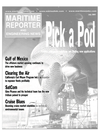
Page 54: of Maritime Reporter Magazine (July 2001)
Read this page in Pdf, Flash or Html5 edition of July 2001 Maritime Reporter Magazine
Podded Propulsion shipbuilders KMY and Fincantieri.
One of the champions of diesel-electric powering, Carnival, gave podded propulsion its start in the cruise ship domain with the commissioning of the
Elation and Paradise in 1998, sparking broader industry uptake of the concept.
Subsequent problems experienced with the systems, which led to an out-of-court settlement between ABB Azipod and
Carnival at the end of last year, prompt- ed certain design modifications.
A technical drawing of Dolphin — A John Crane-Lips / STN Atlas Marine Electronics Podded
Propulsion System. Dolphin's main principle is its powerful electric motor, which drives the pro- peller, installed in a streamlined pod under the vessel.
By the end of May this year, Azipod installations had been specified for 24 cruise vessels, encapsulating a total of 53 pods, and involving newbuild com- mitments extending into 2005. While
Royal Caribbean's Vantage series from
Meyer Werft field the biggest unit power concentrations of 19.5-MW per pod in twin Azipod applications, the same U.S. group's Voyager of the Seas class from
Kvaerner Masa-Yards have the largest array of power through the adoption of three pods of 14-MW apiece. The design offering now extends through the per- formance range up to 25-MW. and has been strengthened in the sector up to 5-
MW by the development of the Compact
Azipod series.
A market breakthrough has been achieved with the specification of the first podded propulsors specified for large crude oil carriers, whereby a 16-
MW Azipod will be used for each of two 106.000-dwt diesel-electric tankers ordered in Japan for deployment with
Fortum Oil & Gas.
The heavily ice-strengthened vessels will serve the Finnish energy group's year-round transportation of crude oil from the North Sea basin to its Baltic refineries. The project provides a break- through in the large tanker sector for
Kvaerner Masa-Yards' double-acting technology, which champions the con- cept of podded drives. Podded propul- sion is central to double-acting technol- ogy, whereby vessels are formed and equipped to sail astern in icebound waters, permitting the use of a hydrody- namically-optimized bow for open- water navigation.
Fortum has the most extensive seago- ing service experience to date of any user of podded propulsors, through its
Nemarc Shipping joint venture with
KMY. Nemarc's two 16,400 dwt Arctic tankers Uikku and Lunni were each retrofitted with a 11.4 MW Azipod in 1993 and 1995, respectively.
The tankers have been booked with
Sumitomo Heavy Industries, where they will be constructed to the Finnish Mar- itime Administration's Ice Class 1A
Super requirements, and incorporate a hull structural design based on a 40-year fatigue life.
By developing a system tailor-made for smaller vessels, ABB has increased the market reach of innovative podded propulsion technology. The Compact
Azipod design has been engineered by the Finnish group for unit power appli- cations in the 400-kW to 5-MW range, and early contractual successes in the offshore field have been followed by survey ship applications for the U.K.
Ministry of Defence. While encapsulat- ing the concept and attendant benefits of the original Azipod series, the latest sys- tem incorporates distinct features influ- enced by the particular design and oper- ating needs of a very large population of small vessels, including ferries, inland vessels, coastal and offshore service vessels. Enhanced maneuverability and operational economy have been the twin objectives have been cornerstone objec- tives in the Compact Azipod develop- ment project.
It is felt that market demand for the Circle 254 on Reader Service Card www.maritimereporterinfo.com
America's most ambitious marine telecommunications project is now delivering superior VHF radiotele- phone service along the Gulf of Mexico and lower Mississippi River. The
MariTEL Network, with its giant radio towers and fiber optic infrastructure, offers far more reliable VHF marine radiotelephone communications and landline connections than the maritime community has ever experienced. MariTEL subscribers can transmit and receive private voice and data from up to 50 miles offshore and the MariTEL Network enables vessel position to be monitored from a computer anywhere in the world.
Mari EL
The Marine Telephone Company
For more information on how MariTEL can benefit your shipping operation, e-mail us at: visit our website: www.maritelusa.com or, call Toll F|ee 1-888-MARITEL. "' " "ik " 46 www.maritimetoday.com Maritime Reporter & Engineering News

 53
53

 55
55
